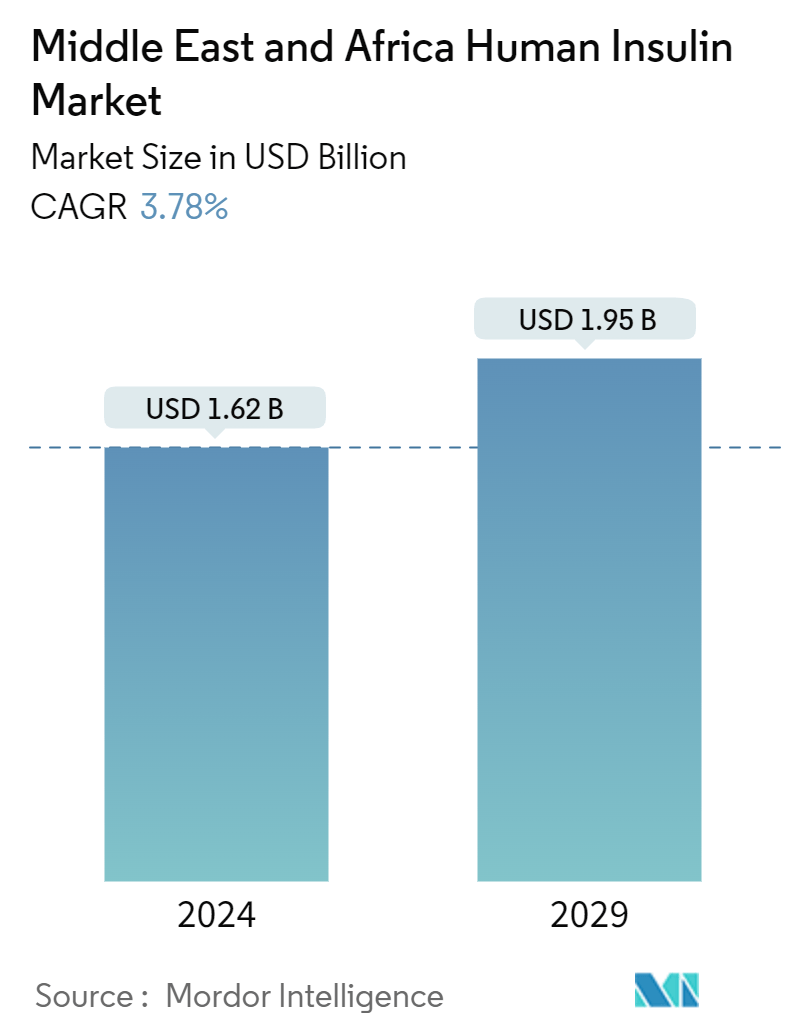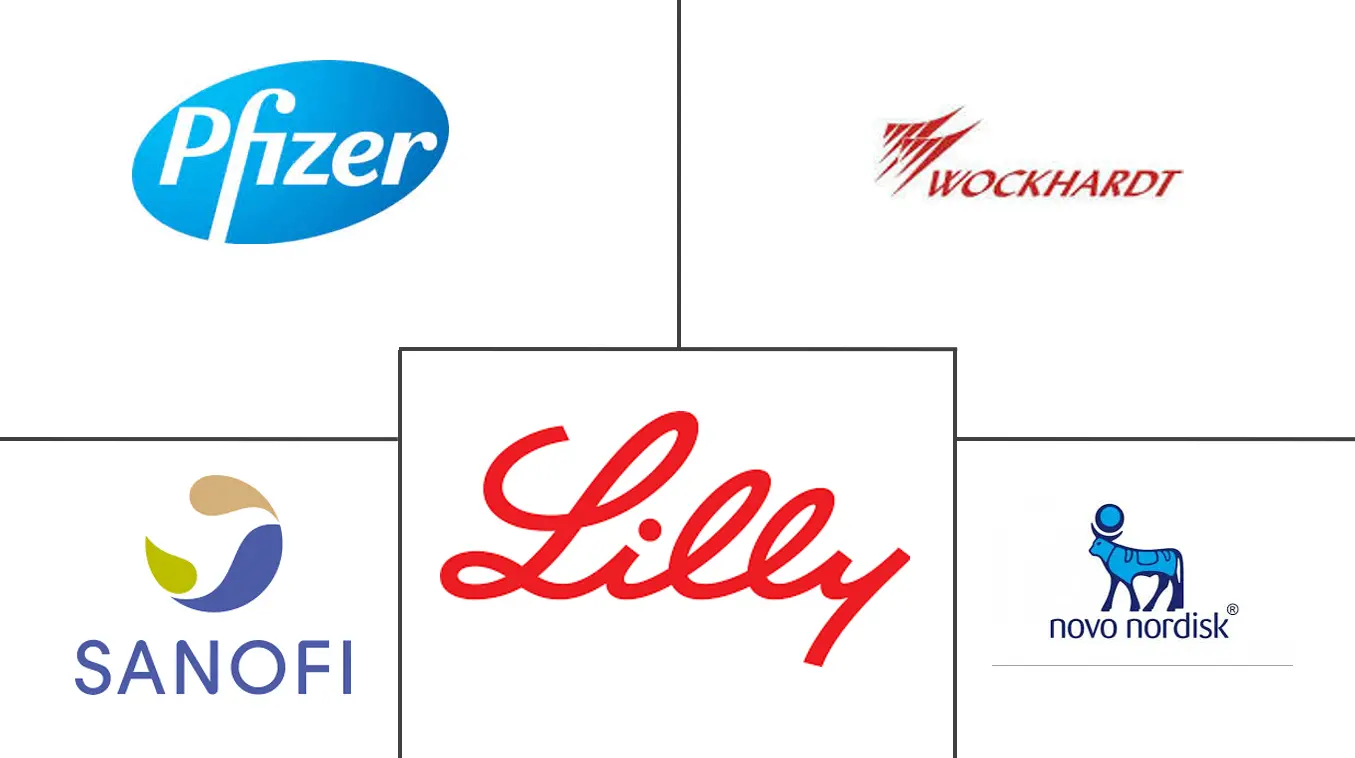Market Size of Middle East And Africa Human Insulin Industry

| Study Period | 2019- 2029 |
| Base Year For Estimation | 2023 |
| Forecast Data Period | 2024 - 2029 |
| Market Size (2024) | USD 1.62 Billion |
| Market Size (2029) | USD 1.95 Billion |
| CAGR (2024 - 2029) | 3.78 % |
Major Players
*Disclaimer: Major Players sorted in no particular order |
Middle East and Africa Diabetes Treatment Market Analysis
The Middle East And Africa Human Insulin Market size is estimated at USD 1.62 billion in 2024, and is expected to reach USD 1.95 billion by 2029, growing at a CAGR of 3.78% during the forecast period (2024-2029).
In the Middle-East and Africa, Type 1 diabetes forms approximately 10% of the diabetes conditions, and Type 2 contributes to 90%. Type 1 patients need to take insulin throughout their lives while maintaining a healthy diet and regular physical exercise.
Type 2 patients need to eat healthily, remain physically active, and perform regular tests to check their blood glucose levels. They may also need to take oral medication and insulin to control the glucose levels in their blood. There are many complications associated with diabetes, like diabetic ketoacidosis and non-ketotic hyperosmolar coma. Serious long-term complications include heart disease, stroke, kidney failure, foot ulcers, and damage to the eyes.
The insulin market is experiencing significant growth due to the rapid increase in the diabetes population in the Middle East and Africa region. Diabetes has become a major health concern in these regions, with a rising number of individuals being diagnosed with the disease.
One of the primary factors driving the growth of the insulin market in the Middle East and Africa is the changing lifestyle and dietary habits of the population. Urbanization, sedentary lifestyles, and the adoption of unhealthy diets high in sugar and processed foods have contributed to the rise in diabetes cases. As a result, there is a growing demand for insulin to manage and control blood sugar levels among diabetic patients.
Additionally, the aging population in the Middle East and Africa is another significant factor contributing to the increased demand for insulin. With advancing age, the risk of developing diabetes increases, leading to a larger diabetic population that requires insulin therapy.
As the production of insulin is very complex, there are very few companies in the market that manufacture insulin. Thus, there is high competition between these manufacturers, and they always strive to meet the patient's needs and supply the best-quality insulin.
Middle East and Africa Diabetes Treatment Industry Segmentation
Regular insulin is a kind of short-acting medical insulin, sometimes referred to as neutral insulin or soluble insulin. Type-1 diabetes, type-2 diabetes, gestational diabetes, and diabetic complications such as diabetic ketoacidosis and hyperosmolar hyperglycemic states are all treated with it. The Middle East and Africa human insulin market is segmented by product type and by geography. The report offers the value (in USD) and volume (in units) for the above segments.
| Product | |||||||
| |||||||
| |||||||
| |||||||
| |||||||
|
| Geography | |
| Saudi Arabia | |
| Iran | |
| Egypt | |
| Oman | |
| South Africa | |
| Rest of Middle East and Africa |
Middle East And Africa Human Insulin Market Size Summary
The Middle East and Africa diabetes treatment market is experiencing significant growth, driven by the increasing prevalence of diabetes in the region. The market is characterized by a high demand for insulin, particularly due to the rising number of diabetes cases attributed to changing lifestyle and dietary habits, urbanization, and an aging population. Type 2 diabetes, which constitutes the majority of cases, often requires patients to manage their condition through a combination of healthy eating, physical activity, and medication, including insulin. The complexity of insulin production has led to a competitive market with few manufacturers striving to meet the diverse needs of diabetic patients. The adoption of biosimilar insulin is gaining traction due to its cost-effectiveness compared to branded insulins, supported by government initiatives to foster a sustainable biosimilar market.
Saudi Arabia stands out in the region with a high prevalence of diabetes, prompting government efforts to reduce its impact through various health initiatives. The market is dominated by major players like Novo Nordisk, Sanofi, and Eli Lilly, alongside local companies such as Biocon and Julphar. Recent developments include the introduction of innovative solutions like EOFlow's wearable insulin pump in the UAE and strategic partnerships aimed at enhancing insulin access in Africa. These efforts reflect a broader trend towards improving diabetes management and treatment accessibility across the Middle East and Africa, with a focus on both technological advancements and cost-effective solutions.
Middle East And Africa Human Insulin Market Size - Table of Contents
-
1. MARKET DYNAMICS
-
1.1 Market Overview
-
1.2 Market Dynamics
-
1.2.1 Market Drivers
-
1.2.2 Market Restraints
-
-
1.3 Industry Attractiveness - Porter's Five Forces Analysis
-
1.3.1 Bargaining Power of Suppliers
-
1.3.2 Bargaining Power of Consumers
-
1.3.3 Threat of New Entrants
-
1.3.4 Threat of Substitute Products and Services
-
1.3.5 Intensity of Competitive Rivalry
-
-
-
2. MARKET SEGMENTATION
-
2.1 Product
-
2.1.1 Basal or Long-acting Insulins
-
2.1.1.1 Lantus (Insulin Glargine)
-
2.1.1.2 Levemir (Insulin Detemir)
-
2.1.1.3 Toujeo (Insulin Glargine)
-
2.1.1.4 Tresiba (Insulin Degludec)
-
2.1.1.5 Basaglar (Insulin Glargine)
-
-
2.1.2 Bolus or Fast-acting Insulins
-
2.1.2.1 NovoRapid/Novolog (Insulin Aspart)
-
2.1.2.2 Humalog (Insulin Lispro)
-
2.1.2.3 Apidra (Insulin Glulisine)
-
-
2.1.3 Traditional Human Insulins
-
2.1.3.1 Novolin/Actrapid/Insulatard
-
2.1.3.2 Humilin
-
2.1.3.3 Insuman
-
-
2.1.4 Combination Insulins
-
2.1.4.1 NovoMix (Biphasic Insulin Aspart)
-
2.1.4.2 Ryzodeg (Insulin Degludec and Insulin Aspart)
-
2.1.4.3 Xultophy (Insulin Degludec and Liraglutide)
-
2.1.4.4 Soliqua/Suliqua (Insulin glargine/Lixisenatide)
-
-
2.1.5 Biosimilar Insulins
-
2.1.5.1 Insulin Glargine Biosimilars
-
2.1.5.2 Human Insulin Biosimilars
-
-
-
2.2 Geography
-
2.2.1 Saudi Arabia
-
2.2.2 Iran
-
2.2.3 Egypt
-
2.2.4 Oman
-
2.2.5 South Africa
-
2.2.6 Rest of Middle East and Africa
-
-
Middle East And Africa Human Insulin Market Size FAQs
How big is the Middle East And Africa Human Insulin Market?
The Middle East And Africa Human Insulin Market size is expected to reach USD 1.62 billion in 2024 and grow at a CAGR of 3.78% to reach USD 1.95 billion by 2029.
What is the current Middle East And Africa Human Insulin Market size?
In 2024, the Middle East And Africa Human Insulin Market size is expected to reach USD 1.62 billion.

